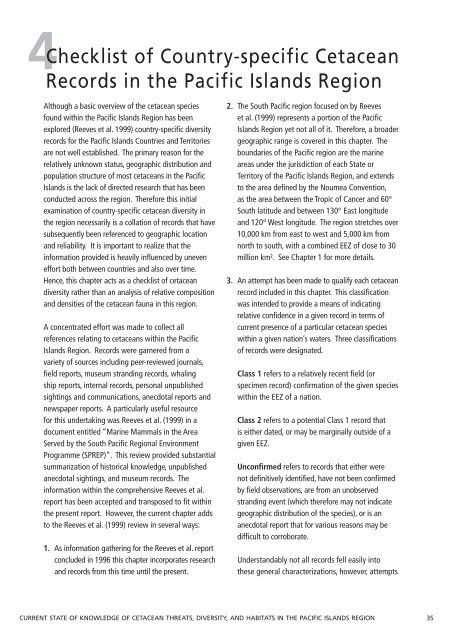pacific islands report_NU.indd - Whale and Dolphin Conservation ...
pacific islands report_NU.indd - Whale and Dolphin Conservation ...
pacific islands report_NU.indd - Whale and Dolphin Conservation ...
Create successful ePaper yourself
Turn your PDF publications into a flip-book with our unique Google optimized e-Paper software.
4Checklist of Country-specific CetaceanRecords in the Pacific Isl<strong>and</strong>s RegionAlthough a basic overview of the cetacean speciesfound within the Pacific Isl<strong>and</strong>s Region has beenexplored (Reeves et al. 1999) country-specific diversityrecords for the Pacific Isl<strong>and</strong>s Countries <strong>and</strong> Territoriesare not well established. The primary reason for therelatively unknown status, geographic distribution <strong>and</strong>population structure of most cetaceans in the PacificIsl<strong>and</strong>s is the lack of directed research that has beenconducted across the region. Therefore this initialexamination of country-specific cetacean diversity inthe region necessarily is a collation of records that havesubsequently been referenced to geographic location<strong>and</strong> reliability. It is important to realize that theinformation provided is heavily influenced by uneveneffort both between countries <strong>and</strong> also over time.Hence, this chapter acts as a checklist of cetace<strong>and</strong>iversity rather than an analysis of relative composition<strong>and</strong> densities of the cetacean fauna in this region.A concentrated effort was made to collect allreferences relating to cetaceans within the PacificIsl<strong>and</strong>s Region. Records were garnered from avariety of sources including peer-reviewed journals,field <strong>report</strong>s, museum str<strong>and</strong>ing records, whalingship <strong>report</strong>s, internal records, personal unpublishedsightings <strong>and</strong> communications, anecdotal <strong>report</strong>s <strong>and</strong>newspaper <strong>report</strong>s. A particularly useful resourcefor this undertaking was Reeves et al. (1999) in adocument entitled “Marine Mammals in the AreaServed by the South Pacific Regional EnvironmentProgramme (SPREP)”. This review provided substantialsummarization of historical knowledge, unpublishedanecdotal sightings, <strong>and</strong> museum records. Theinformation within the comprehensive Reeves et al.<strong>report</strong> has been accepted <strong>and</strong> transposed to fit withinthe present <strong>report</strong>. However, the current chapter addsto the Reeves et al. (1999) review in several ways:1. As information gathering for the Reeves et al. <strong>report</strong>concluded in 1996 this chapter incorporates research<strong>and</strong> records from this time until the present.2. The South Pacific region focused on by Reeveset al. (1999) represents a portion of the PacificIsl<strong>and</strong>s Region yet not all of it. Therefore, a broadergeographic range is covered in this chapter. Theboundaries of the Pacific region are the marineareas under the jurisdiction of each State orTerritory of the Pacific Isl<strong>and</strong>s Region, <strong>and</strong> extendsto the area defined by the Noumea Convention,as the area between the Tropic of Cancer <strong>and</strong> 60°South latitude <strong>and</strong> between 130° East longitude<strong>and</strong> 120° West longitude. The region stretches over10,000 km from east to west <strong>and</strong> 5,000 km fromnorth to south, with a combined EEZ of close to 30million km². See Chapter 1 for more details.3. An attempt has been made to qualify each cetaceanrecord included in this chapter. This classificationwas intended to provide a means of indicatingrelative confidence in a given record in terms ofcurrent presence of a particular cetacean specieswithin a given nation’s waters. Three classificationsof records were designated.Class 1 refers to a relatively recent field (orspecimen record) confirmation of the given specieswithin the EEZ of a nation.Class 2 refers to a potential Class 1 record thatis either dated, or may be marginally outside of agiven EEZ.Unconfirmed refers to records that either werenot definitively identified, have not been confirmedby field observations, are from an unobservedstr<strong>and</strong>ing event (which therefore may not indicategeographic distribution of the species), or is ananecdotal <strong>report</strong> that for various reasons may bedifficult to corroborate.Underst<strong>and</strong>ably not all records fell easily intothese general characterizations, however, attemptsCURRENT STATE OF KNOWLEDGE OF CETACEAN THREATS, DIVERSITY, AND HABITATS IN THE PACIFIC ISLANDS REGION 35
















